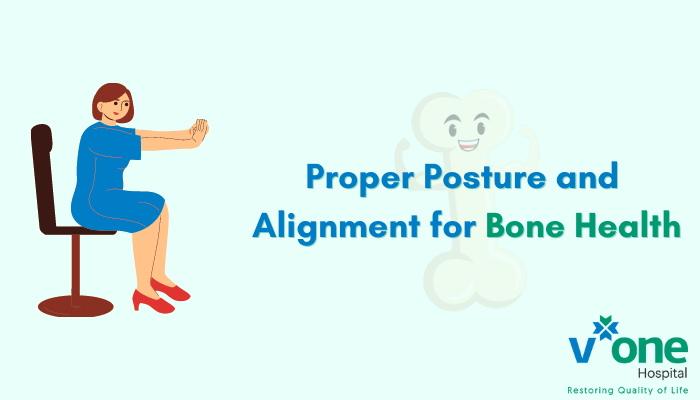A Backbone for Bone Health: The Importance of Good Posture
Have your elders ever told you to stop hunching over and adopt a better posture? It may be annoying to hear it, but as it turns out, there is a lot of truth to the advice. Maintaining good posture and proper alignment is essential for your overall health, especially your bone health.
Your bones provide support and structure to your body, and without proper posture and alignment, you may be putting unnecessary stress and pressure on your bones, leading to a higher risk of fractures, osteoporosis, and other bone-related conditions. Good posture plays a key role in bone health, and you can work to improve both.
What is Proper Posture and Alignment?
Your posture is the position of your body when you stand, sit, or lie down. It is essential to maintain good posture to avoid unnecessary stress on your bones, muscles, and joints. Proper alignment refers to the correct positioning of your bones and joints, so they are in their natural, healthy positions. When you are aligned properly, it helps distribute your body weight evenly, reducing stress on specific areas and preventing joint and bone pain.
How Do Your Posture and Alignment Affect Bone Health?
Good posture keeps your muscles, tendons, and ligaments working properly, allowing them to effectively do their job. But when they aren’t functioning properly, they may not be able to provide proper support for all the bones in your body.
Maintaining good posture and proper alignment is one of the best things you can do to keep your bones healthy. Poor posture puts unnecessary pressure on your bones and joints, leading to premature wear and tear. Over time, this can lead to osteoporosis, a condition in which your bones become fragile and brittle. Osteoporosis then increases your risk of fractures, especially in the spine, hip, and wrist.
Poor posture can also lead to muscle weakness, which can further increase your risk of falls and fractures. It can also cause neck and back pain, headaches, fatigue, muscle imbalances, reduce flexibility, joint pain, arthritis, and reduced mobility. Maintaining good posture and alignment can help prevent these issues and keep your bones healthy and strong.
How to Improve Your Posture (and Alignment)?
Working on your posture and alignment can help reduce your risk of bone-related conditions and improve your overall health. But you don’t need a gym to improve your posture. Here is what you can do to improve your posture and alignment at home:
- Stand up straight: Keep your shoulders back and your head level. Avoid slouching or leaning to one side.
- Sit properly: Sit with your back straight, and your feet flat on the floor. Use a chair with good back support to maintain proper alignment.
- Use good body mechanics: When lifting heavy objects, bend your knees and keep your back straight. Use your legs to lift the weight, not your back.
- Exercise regularly: Regular exercise helps strengthen your bones and muscles, improving your posture and alignment.
- Wear comfortable shoes: Wearing shoes that provide good support can help improve your posture and alignment.
- Get regular check-ups: Regular check-ups with your doctor or a physical therapist can help identify and correct any posture or alignment issues before they become more severe.
What to Expect During and After a Non-Surgical Facelift
Choosing a non-surgical facelift is a convenient and low-risk option for facial rejuvenation, but knowing what to expect at each stage can help you feel more prepared and confident. Here’s a detailed look at what typically happens before, during, and after the procedure:
Before the Procedure: Consultation and Custom Treatment Plan
Your non-surgical facelift journey begins with a one-on-one consultation with a qualified aesthetic specialist or plastic surgeon. During this session:
-
Your medical history, skin concerns, and aesthetic goals are thoroughly discussed.
-
The doctor will assess your facial anatomy, skin texture, and degree of volume loss or sagging.
-
Based on this evaluation, a customized treatment plan is created—selecting the right combination of techniques such as dermal fillers, Botox, thread lifts, or laser treatments.
The practitioner will also explain the expected outcomes, number of sessions required (if any), potential side effects, and answer any questions you may have.
During the Procedure: Minimally Invasive and Comfortable
Non-surgical facelift procedures are typically performed in a clinical setting and usually take between 30 minutes to 1 hour, depending on the treatment plan.
-
Numbing cream or local anesthesia is applied to minimize discomfort during injections or other procedures.
-
For injectable treatments like dermal fillers and Botox, fine needles are used to administer the substances precisely in targeted areas.
-
For thread lifts, dissolvable threads are inserted just beneath the skin to lift sagging areas.
-
Energy-based treatments (like radiofrequency or ultrasound) are delivered via handheld devices that glide across the skin.
Most patients describe the sensation as mild pressure or pinching, but generally tolerable. The process is quick, and you can usually leave the clinic right after the session.
After the Procedure: Recovery, Results, and Care
One of the biggest advantages of non-surgical facelifts is minimal downtime. However, you may experience temporary side effects, such as:
-
Mild redness or swelling at the injection sites
-
Bruising (especially with fillers or thread lifts), which typically subsides in 2–5 days
-
Tightness or sensitivity, depending on the technique used
To ensure the best results, follow these common post-treatment care tips:
-
Avoid touching or massaging the treated areas for 24 hours
-
Refrain from intense physical activity, heat exposure, or alcohol consumption for at least 48 hours
-
Apply cold compresses to reduce swelling if needed
-
Sleep with your head slightly elevated the first night
Most patients see noticeable improvements immediately, with full results becoming visible over a few days to weeks, especially when collagen stimulation is involved.
A follow-up appointment may be scheduled to monitor your results or provide touch-ups if necessary. With the right care and maintenance, the results of your non-surgical facelift can last 6–18 months, depending on the type of treatment.
Your genetics, lifestyle, and habits together can influence your posture. Maintaining good posture and alignment requires conscious effort and practice. And although it can take time to develop new habits and undo old ones, it is certainly possible. With regular exercise and a few lifestyle changes, you can improve your posture and strengthen your bones and muscles. You should also ditch those heels and go for more supportive shoes instead.
Good posture and alignment are often a window into your bone health, but they also play a key role in affecting your bone health. Poor posture and alignment can have long-term consequences for your bone and joint health. Poor posture doesn’t just look bad, it can put unnecessary stress on your bones and joints, and increase your risk of fractures and osteoporosis, along with causing reduced lung function and increasing the risk of respiratory issues. It can also cause muscle imbalances, cause joint pain, and reduce flexibility.
Role of Nutrition and Hydration in Bone Health
While good posture is vital for maintaining bone and joint health, it works best when combined with proper nutrition and hydration. Your bones need the right nutrients to stay strong, flexible, and capable of withstanding the daily mechanical stress—especially the kind caused by poor alignment or posture imbalances.
Calcium is the primary building block of bone tissue. Without adequate calcium intake, your body may begin to draw calcium from your bones, leading to decreased bone density and increased fracture risk. Vitamin D is equally essential because it helps your body absorb calcium more efficiently. A deficiency in vitamin D can contribute to weaker bones and conditions like osteoporosis.
In addition to calcium and vitamin D, nutrients such as magnesium, phosphorus, and vitamin K also support bone regeneration and density. Include foods like dairy products, leafy greens, nuts, seeds, fish, and fortified cereals in your diet to help nourish your bones from the inside out.
Hydration is another often-overlooked factor. Water plays a crucial role in maintaining the elasticity of tissues and the lubrication of joints. Dehydration can lead to muscle fatigue, stiffness, and joint discomfort, all of which affect posture and alignment. Staying well-hydrated helps your muscles and joints function optimally, reducing strain on your bones.
A well-rounded approach—combining posture awareness with nutritional support—can significantly enhance your bone resilience and long-term skeletal health.
When to Seek Professional Help?
Improving posture and maintaining bone health often starts with lifestyle changes—but persistent discomfort or visible issues should not be ignored. If you’ve made efforts to improve your posture but continue to experience chronic back pain, joint stiffness, muscle fatigue, or an inability to stand or sit upright comfortably, it may be time to consult a professional.
A physiotherapist can evaluate your posture, recommend corrective exercises, and help retrain your body to adopt healthier movement patterns. They also use targeted therapies to address muscular imbalances or tension that might be contributing to poor posture.
If you’re experiencing structural concerns like spinal misalignment, persistent joint issues, or suspected bone weakness, visiting an orthopaedic specialist is advised. They can perform diagnostic imaging to rule out underlying bone or joint conditions and offer treatment options tailored to your needs.
Additionally, chiropractors specialize in spinal alignment and may offer non-invasive adjustments to correct posture-related issues, especially if misalignment is causing nerve pressure or musculoskeletal pain.
Don’t wait until pain becomes severe—early intervention can prevent long-term complications and make posture correction significantly more effective. Listening to your body and seeking expert guidance when necessary is a crucial part of maintaining both posture and bone health.
Maintaining good posture and alignment can help prevent these issues and keep your bones healthy and strong. By following the tips mentioned above and making healthy lifestyle changes, you can improve your posture and alignment, and reduce your risk of bone-related conditions. Taking steps to improve your posture and alignment now can help prevent these issues and keep you healthy and active for years to come.

